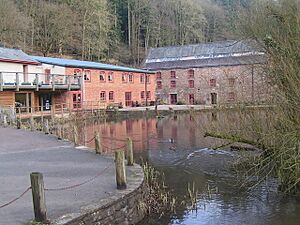Dean Heritage Centre facts for kids
The Dean Heritage Centre is a special place in the Forest of Dean, England. It's located in the beautiful valley of Soudley, Gloucestershire. This centre helps us remember and protect the history of the area and its people, especially how they worked and lived.
At the centre, you can explore the museum, see a millpond with a working waterwheel, and visit a forester's cottage with a garden and animals. There are also art and craft displays, workshops, and walking trails through the nearby woods. For fun, you'll find picnic areas, barbecue spots, an adventure playground, a gift shop with local items, and a restaurant called Heritage Kitchen that serves homemade food.
Contents
Discovering the Forest's Past
The main museum has five different rooms, called galleries. These galleries tell the story of the Forest of Dean from its very beginning, with old rocks and fossils, all the way to today. You'll see many interesting objects from industries that were important here. These include coal and iron mining, working with trees, wood, and stone, and even clock making. These jobs really shaped the history, look, and culture of the Forest.
Some of the cool things you can see in the museum are an old beam engine from a coal mine (from the 1830s), a detailed model of the Forest's geology made in 1838 by Thomas Sopwith, and a collection of tall longcase clocks from the 1700s and 1800s.
The Dean Heritage Museum Trust is a charity that started in 1979. People were worried that the history of the Forest of Dean was being forgotten. So, the trust bought an old corn mill called Camp Mill and opened the museum there in 1983. The museum got a big update in 2003, thanks to money from the Heritage Lottery Fund.
The Millpond and Nature
The museum grounds feature a lovely millpond. Water from this pond helps power a restored waterwheel. A stream from Morgan's Pool, which is one of the Soudley Ponds, feeds the millpond. The pond is home to many mallard and mandarin ducks. You might also spot other birds like dippers, kingfishers, grey wagtails, and grey herons.
From the museum, you can follow a special forestry trail. This path goes through very old oak and beech woods, leading up to the top of Bradley Hill. From there, you get an amazing view of the whole valley. You can see the Zion Chapel, built in 1846, and an old railway tunnel that was dug in 1894 and runs under the hill.
A Forester's Home and Garden
On the museum grounds, there's a reconstructed forester's cottage from the early 1900s. It was carefully moved stone by stone from its original spot. The cottage is decorated and furnished just like homes were in the Victorian and Edwardian times.
Like many Forest cottages back then, it has two rooms upstairs and two rooms downstairs. On the ground floor, there's a cozy sitting room with a harmonium (a type of organ), a Victorian chaise-longue (a long chair), and a collection of old china. There's also a kitchen with a real cast-iron stove.
Upstairs, you'll find two bedrooms: a children's room and a main bedroom that also has a baby cot. These bedrooms don't have wardrobes. Instead, people used chests to store their clothes, just like they did in those days. Outside, there's a wash-house with a copper pot for washing clothes, along with a washing dolly and a mangle (a machine for squeezing water out of clothes).
Behind the house, there's a garden. It's planted with vegetables that were common during that time period.
Charcoal Burners' Camp
You can also visit a charcoal burners’ camp at the centre. It's set up in a forest clearing with a hut made from stone and turf, just as they have been built for hundreds of years. In the past, whole families would live in the Forest for months during the summer. They did this to constantly watch over several charcoal burns at once.
The Heritage Centre keeps this tradition alive by doing charcoal burns twice a year. They build them in the old way, stacking wood tightly into a dome, then covering it with turf and earth. This stops oxygen from getting in, making sure the wood dries out at a high temperature without burning completely. The charcoal made long ago was used to get the very high temperatures needed to melt iron ore found in the Forest. Today, however, the charcoal is mostly sold for barbecues.
Freemine Entrance
The Heritage Centre covers five acres of thick woodland. Here, you can also see Harvey's Folly, which is a copy of a freemine entrance. It was built for the centre by a retired freeminer named Dave Harvey.
The right to mine for coal in the Forest of Dean is very old. It's believed that Edward II first gave this right to any man born within the traditional boundaries of the Forest (an area known as the Hundred of St Briavels) who had worked underground for a year and a day.
The Gage Library
The Gage Library opened in 1995. It's a great place for learning about the local history of the Forest of Dean. The library received a large gift from Laurie Gage, who was an old book dealer and a generous person with a strong interest in the area. He passed away in 1994.
The Library has over 1,500 books about the history, geography, and nature of the Forest of Dean and the Wye Valley. It also has an impressive collection of old maps from the 1700s onwards, along with papers from many important local people from the last two centuries.
Events and Activities
The museum always has a busy schedule of events. These include craft markets, pumpkin carving around Halloween, and a traditional Santa visit at Christmas. During school holidays, there are often special craft events for families to enjoy.





